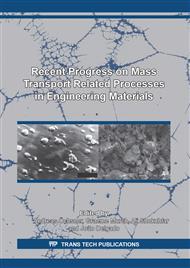p.3
p.11
p.21
p.32
p.38
p.45
p.51
p.59
Modelling Mass Transference and Two-Directions Diffusion Coefficients in an Ellipse-Shaped Body under Multi-Factor and Un-Steady Conditions
Abstract:
Regarding mass transference and diffusion, very important contributions have been made through time. Numerical solutions (mostly) have been applied to plane sheets, spheres and cylinder-shaped bodies. Most of these studies were related to only one direction and specific conditions i.e, solute concentrations or stirring conditions or diffusion distances and time. However, it is difficult to find models for more than one direction and other shaped bodies as well as their behaviour under multifactor and unsteady conditions. Therefore, the aims of this study were: 1) to confirm that a pre-obtained first-order function can be used to estimate velocity of mass transferred and diffusion coefficients as function of an un-steady and multi-factor system (amount of solvent, agitation time, amount of material diffused and time) on a ellipse-shaped body; 2) to demonstrate that inferred diffusion coefficients respect Fick`s first and second laws and Walstra ́s general diffusion equation; and 3) to model inferred mass transference and two-dimension diffusion coefficients within the un-steady and multi-factor system. As for the methodology, the first order function obtained previously, a created algorithm (based on analytic mathematics, numerical and graphical solutions) and the computer programme Expert Design v.11 were used to infer solutions. Results show models with very good accuracy (p< 0.001, r2 > 0.99, Fraction of Design Space ͠100%) and an easy-to-use graphical solution.
Info:
Periodical:
Pages:
3-10
Citation:
Online since:
March 2020
Authors:
Price:
Сopyright:
© 2020 Trans Tech Publications Ltd. All Rights Reserved
Share:
Citation:


